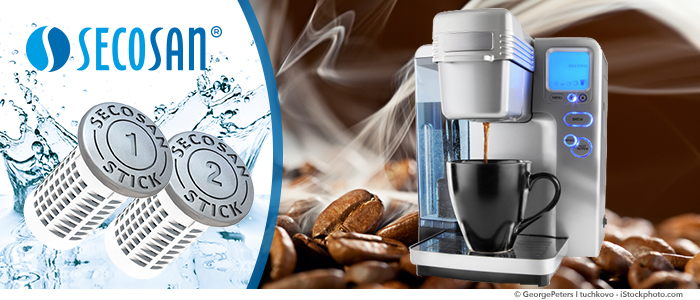 Germany is a country of coffee lovers – the average German citizen drinks about 162 litres per year. But today our attention is on coffee machine hygiene. Researchers have discovered that germs settle in coffee grounds and in used capsules and pods, including mould spores that end up in the coffee. Time for some hygiene tips from food microbiologists and from trade association specialists for household appliances!
Germany is a country of coffee lovers – the average German citizen drinks about 162 litres per year. But today our attention is on coffee machine hygiene. Researchers have discovered that germs settle in coffee grounds and in used capsules and pods, including mould spores that end up in the coffee. Time for some hygiene tips from food microbiologists and from trade association specialists for household appliances!
The bad news: Wet coffee grounds promote the growth of mould. If, for example, an old pod remains in the machine for a few days, upon the next use mould spores may remain in the pod holder, which then get into the coffee. So-called mycotoxins form – heat-stable toxins that can neither be seen nor tasted.
Water tanks and plastic tubes can also be a real breeding ground for bacteria if they are not cleaned well, as bacteria like to settle there in the form of biofilms. These are mucous-like deposits that should be thoroughly eliminated. Many coffee machines do have self-cleaning programmes, but all removable parts should nevertheless be regularly cleaned, manually or in a dishwasher. Any places where heat and moisture are at work must be especially carefully inspected and cleaned.
-
Brew group
It is sufficient to clean machines with removable brew units by hand once a week with clear water and no detergent. Important: Let the brew group dry completely before you place it back in the machine. If the filter is clogged, try to clear out the holes with a brush.
What if the brew group isn’t removable? Then it is generally constructed in such a way that coffee grounds cannot escape, which minimises the risk of mould. In this case, the manufacturer cleaning programme is sufficient, which usually uses water heated to 70 degrees. The display usually informs you when this programme needs to be used.
-
Waste containers
The coffee waste container collects the coffee grounds after the coffee is prepared, and it should be emptied, cleaned and dried thoroughly every day. The drip tray under the coffee spout must also be cleaned regularly, if possible in the dishwasher.
-
Milk foamer
An absolute must for hygiene is cleaning the milk foamer daily with hot water. Make sure that no milk residue remains after cleaning – otherwise it dries and is an easy target for germs.
-
Water tank
The water tank must also be emptied daily, cleaned with a brush and detergent and dried thoroughly. Because water should not remain in the tank for too long, it is recommended that it be changed at least every four hours. Under no circumstances should water be left in the tank for multiple days. The only exception: When you use SecoSan Sticks, the water can be used all day without a second thought – because the silver ions on the sticks immediately neutralise the bacteria and germs in the water.
-
Decalcification
Regular decalcification is important for coffee machines, especially in hard water areas. Bacteria can cling much more easily to rough limescale than to a smooth surface.
SecoSan – pure water for total aromatic pleasure
Only fresh and pure water properly brings out the fine aroma of coffee. In the water tank of your coffee machine, SecoSan ensures a real taste experience, using the age-old principle that silver keeps water pure: The silver ions in the stick close around bacteria and germs, thus preventing them from multiplying – for up to 6 months regardless of temperature.
SecoSan Stick 1 protects up to 0.7 litres of water from germ multiplication, and SecoSan Stick 2 protects up to 2 litres. The water can be replaced, refreshed or filled up at any time – effectiveness is guaranteed up to 6 months! Order today and take advantage of our current offer price:
- SecoSan Stick 1 3-pack reduced from £25.43 to just £9.42
- SecoSan Stick 1 6-pack reduced from £50.87 to just £17.01
- SecoSan Stick 2 2-pack reduced from £18.85 to just £9.42
incl. VAT. – now in the Trotec shop!

